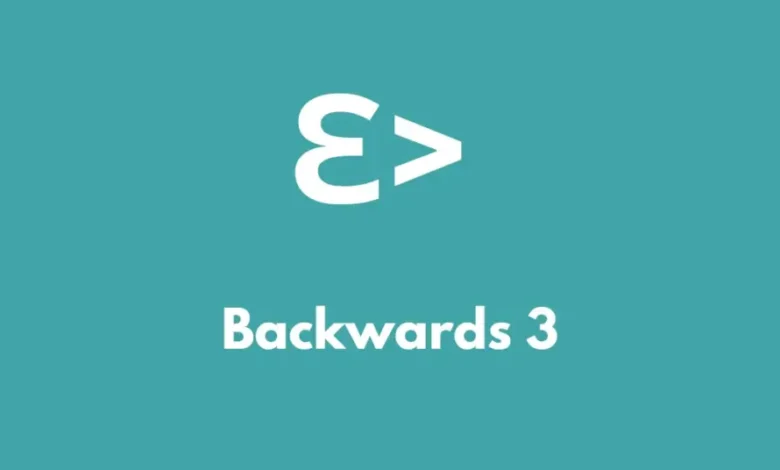Backwards 3: Why It’s Trending in Modern Culture

Introduction
In today’s rapidly evolving world, traditional strategies often fall short in delivering groundbreaking results. Enter the concept of “Backwards 3,” a revolutionary approach that emphasizes thinking and acting in reverse to achieve unparalleled success. This methodology, which can be applied across various domains such as SEO, business, and problem-solving, challenges conventional wisdom by advocating for a unique perspective on strategy and execution. By reversing the traditional thought process, professionals and businesses can uncover hidden opportunities, optimize performance, and outmaneuver competitors.
The “Backwards 3” concept draws on the idea that by starting with the end goal in mind and working backward, one can create more effective strategies and solutions. This approach not only fosters creativity and innovation but also provides a structured pathway to achieving desired outcomes. In the following sections, we will delve into the intricacies of this concept, exploring its applications in SEO, business strategies, and real-world examples. Whether you’re an SEO specialist, a business owner, or simply someone looking to enhance problem-solving skills, understanding and implementing the “Backwards 3” methodology can offer transformative benefits.
Understanding the Concept of Backwards 3
The “Backwards 3” concept is rooted in the idea of reverse engineering—a process where one begins with the end result and works backward to determine the necessary steps to achieve it. This method has historical significance and has been employed in various fields, from engineering to strategic planning. By focusing on the final objective first, individuals and organizations can identify potential obstacles, streamline processes, and ensure that all actions align with their ultimate goals.
Historically, reverse engineering has been a critical tool in innovation and problem-solving. For example, in technology, engineers often dismantle existing products to understand their design and functionality, which can then be used to improve or create new products. Similarly, in business, analyzing successful outcomes and working backward can reveal valuable insights into the strategies and actions that led to those results. This approach contrasts sharply with traditional methods, which typically involve planning from the ground up without fully considering the end result.
By adopting the “Backwards 3” mindset, individuals and organizations can leverage a unique perspective that challenges conventional methods. This approach encourages a more strategic and holistic view, allowing for a deeper understanding of the processes and actions required to achieve success. Whether applied to SEO, business strategies, or problem-solving, the “Backwards 3” concept provides a powerful framework for innovation and achievement.
The Application of Backwards 3 in SEO
Keyword Research
One of the most impactful applications of the “Backwards 3” concept is in keyword research. Traditionally, SEO professionals begin by identifying potential keywords and then developing content around those keywords. However, by applying a reverse approach, you can start by analyzing the competition and identifying the keywords they rank for. This method allows you to uncover high-value keywords that may not be immediately obvious through conventional research methods.
By working backward from successful competitors’ keyword strategies, you can identify gaps and opportunities in your own SEO approach. This involves analyzing competitor websites, understanding their keyword usage, and determining which keywords are driving their traffic. With this information, you can tailor your own content and optimization efforts to target these valuable keywords, potentially improving your search engine rankings and driving more organic traffic.
Content Creation
When it comes to content creation, the “Backwards 3” approach can also be highly effective. Instead of starting with a topic and crafting content around it, consider working backward from the desired outcome. For example, if your goal is to rank for a specific keyword or address a particular user intent, create content that directly addresses those needs. This reverse approach ensures that your content is highly relevant and aligned with user expectations.
By focusing on the end goal first, you can develop content that meets specific objectives and provides value to your audience. This might involve creating comprehensive guides, answering frequently asked questions, or addressing common pain points. By starting with the desired outcome and working backward, you can create content that is more likely to engage readers and achieve your SEO goals.
Link Building
Link building is another area where the “Backwards 3” concept can be applied effectively. Instead of starting with a broad link-building strategy, begin by analyzing the link profiles of top-performing competitors. Identify the types of links they have acquired, the sources of those links, and the strategies they used to obtain them. This reverse engineering approach can help you develop a more targeted and effective link-building strategy.
By understanding the link-building tactics that have worked for your competitors, you can adapt and refine your own approach. This might involve reaching out to similar sources for backlinks, creating high-quality content that naturally attracts links, or leveraging existing relationships to build valuable connections. The “Backwards 3” approach ensures that your link-building efforts are informed by successful strategies and aligned with your overall SEO objectives.
Competitor Analysis
Competitor analysis is a critical component of any SEO strategy, and the “Backwards 3” approach offers a fresh perspective on this process. Instead of simply analyzing competitors’ websites and strategies, start by examining their successes and working backward to understand the factors that contributed to their achievements. This involves looking at their top-performing pages, traffic sources, and keyword rankings to gain insights into their strategies.
By applying this reverse engineering approach, you can identify areas where your own SEO efforts can be improved. For example, if you discover that a competitor’s blog posts are driving significant traffic, analyze the topics, formats, and promotion strategies they use. Use this information to inform your own content creation and optimization efforts, ensuring that your SEO strategy is competitive and effective.
Using Backwards 3 in Business Strategies
Product Development
In the realm of product development, the “Backwards 3” approach can lead to innovative solutions and successful products. Rather than starting with an idea and developing it incrementally, begin by envisioning the final product and working backward to determine the necessary steps and features. This reverse approach allows you to focus on creating a product that meets specific customer needs and market demands from the outset.
By working backward from the desired product outcome, you can identify potential challenges and ensure that all aspects of product development are aligned with your goals. This might involve conducting market research, defining key features, and developing prototypes that address specific user needs. The “Backwards 3” approach helps streamline the development process and increase the likelihood of creating a successful product.
Marketing Campaigns
The “Backwards 3” concept is also valuable for designing effective marketing campaigns. Instead of starting with a general marketing strategy, begin by defining your campaign goals and working backward to determine the most effective tactics and channels. This approach ensures that your marketing efforts are aligned with your objectives and focused on achieving measurable results.
By starting with the end goal, you can develop targeted marketing messages, select the most appropriate channels, and create a cohesive campaign strategy. This might involve identifying key performance indicators (KPIs), setting measurable objectives, and developing a detailed plan for reaching your target audience. The “Backwards 3” approach ensures that your marketing campaigns are strategic, focused, and designed to deliver tangible outcomes.
Problem-Solving
When faced with complex business challenges, the “Backwards 3” approach can be a powerful problem-solving tool. Instead of tackling problems from the ground up, start by defining the desired outcome and working backward to identify potential solutions and strategies. This reverse approach allows you to address issues more effectively and ensure that all actions are aligned with your ultimate goals.
By applying the “Backwards 3” mindset to problem-solving, you can develop more creative and effective solutions. This might involve analyzing successful case studies, identifying best practices, and leveraging insights from previous experiences. The “Backwards 3” approach helps you approach problems with a clear understanding of the desired outcome, increasing the likelihood of finding innovative and successful solutions.
Practical Examples and Case Studies
SEO Case Study
One notable example of the “Backwards 3” concept in action is a case study involving a successful SEO campaign. In this case, an SEO specialist used reverse engineering to analyze the keyword strategies of top competitors. By identifying high-value keywords and understanding the tactics used by competitors, the specialist was able to develop a targeted SEO strategy that significantly improved search engine rankings and drove increased organic traffic.
The reverse engineering approach involved analyzing competitors’ content, backlink profiles, and keyword rankings to identify opportunities and gaps. By working backward from the successful strategies of competitors, the specialist was able to create a more effective and targeted SEO campaign, resulting in improved visibility and performance in search engine results.
Business Case Study
In the business realm, a successful case study of the “Backwards 3” approach involved a company that used reverse engineering to develop a new product. By starting with the desired product outcome and working backward, the company was able to identify key features and design elements that met customer needs and market demands. This approach led to the successful launch of a highly sought-after product and a significant increase in market share.
The reverse engineering process involved conducting thorough market research, defining customer needs, and developing prototypes that aligned with the desired product outcome. By focusing on the end goal first, the company was able to streamline the product development process and create a product that resonated with customers and stood out in the market.
Lessons Learned
From these case studies, several key lessons can be drawn about the effectiveness of the “Backwards 3” approach. First, starting with the end goal and working backward provides a clear and focused strategy for achieving success. Second, reverse engineering allows for a deeper understanding of successful tactics and strategies, leading to more effective implementation. Finally, the “Backwards 3” concept fosters creativity and innovation by challenging traditional methods and encouraging new perspectives.
Conclusion
The “Backwards 3” concept offers a powerful and innovative approach to achieving success in various domains. By starting with the end goal and working backward, individuals and organizations can develop more effective strategies, optimize performance, and uncover hidden opportunities. Whether applied to SEO, business strategies, or problem-solving, the “Backwards 3” methodology provides a unique framework for achieving transformative results.
Adopting the “Backwards 3” mindset encourages a strategic and holistic view, allowing for a deeper understanding of the processes and actions required to achieve success. By experimenting with reverse strategies and leveraging the insights gained from successful case studies, professionals and businesses can enhance their approach and achieve their goals with greater efficiency and effectiveness.





